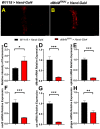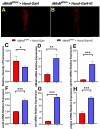Regular Exercise Rescues Heart Function Defects and Shortens the Lifespan of Drosophila Caused by dMnM Downregulation
- PMID: 36554435
- PMCID: PMC9779684
- DOI: 10.3390/ijerph192416554
Regular Exercise Rescues Heart Function Defects and Shortens the Lifespan of Drosophila Caused by dMnM Downregulation
Abstract
Although studies have shown that myomesin 2 (MYOM2) mutations can lead to hypertrophic cardiomyopathy (HCM), a common cardiovascular disease that has a serious impact on human life, the effect of MYOM2 on cardiac function and lifespan in humans is unknown. In this study, dMnM (MYOM2 homologs) knockdown in cardiomyocytes resulted in diastolic cardiac defects (diastolic dysfunction and arrhythmias) and increased cardiac oxidative stress. Furthermore, the knockdown of dMnM in indirect flight muscle (IFM) reduced climbing ability and shortened lifespan. However, regular exercise significantly ameliorated diastolic cardiac dysfunction, arrhythmias, and oxidative stress triggered by dMnM knockdown in cardiac myocytes and also reversed the reduction in climbing ability and shortening of lifespan caused by dMnM knockdown in Drosophila IFM. In conclusion, these results suggest that Drosophila cardiomyocyte dMnM knockdown leads to cardiac functional defects, while dMnM knockdown in IFM affects climbing ability and lifespan. Furthermore, regular exercise effectively upregulates cardiomyocyte dMnM expression levels and ameliorates cardiac functional defects caused by Drosophila cardiomyocyte dMnM knockdown by increasing cardiac antioxidant capacity. Importantly, regular exercise ameliorates the shortened lifespan caused by dMnM knockdown in IFM.
Keywords: IFM; cardiac function; dMnM; lifespan; regular exercise.
Conflict of interest statement
The authors declare no conflict of interest.
Figures








Similar articles
-
Identification of MYOM2 as a candidate gene in hypertrophic cardiomyopathy and Tetralogy of Fallot, and its functional evaluation in the Drosophila heart.Dis Model Mech. 2020 Dec 18;13(12):dmm045377. doi: 10.1242/dmm.045377. Dis Model Mech. 2020. PMID: 33033063 Free PMC article.
-
Dystrophin deficiency in Drosophila reduces lifespan and causes a dilated cardiomyopathy phenotype.Aging Cell. 2008 Mar;7(2):237-49. doi: 10.1111/j.1474-9726.2008.00367.x. Epub 2008 Jan 23. Aging Cell. 2008. PMID: 18221418 Free PMC article.
-
Endurance exercise upregulates mtp expression in aged Drosophila to ameliorate age-related diastolic dysfunction and extend lifespan.Physiol Rep. 2024 Feb;12(3):e15929. doi: 10.14814/phy2.15929. Physiol Rep. 2024. PMID: 38307709 Free PMC article.
-
The R249Q hypertrophic cardiomyopathy myosin mutation decreases contractility in Drosophila by impeding force production.J Physiol. 2019 May;597(9):2403-2420. doi: 10.1113/JP277333. Epub 2019 Apr 4. J Physiol. 2019. PMID: 30950055 Free PMC article.
-
Longevity and the stress response in Drosophila.Exp Gerontol. 2007 Mar;42(3):153-9. doi: 10.1016/j.exger.2006.09.014. Epub 2006 Nov 15. Exp Gerontol. 2007. PMID: 17110070 Review.
Cited by
-
Experimental Models of Hypertrophic Cardiomyopathy: A Systematic Review.JACC Basic Transl Sci. 2025 Apr;10(4):511-546. doi: 10.1016/j.jacbts.2024.10.017. Epub 2025 Jan 15. JACC Basic Transl Sci. 2025. PMID: 40306862 Free PMC article. Review.
References
Publication types
MeSH terms
Substances
LinkOut - more resources
Full Text Sources
Medical
Molecular Biology Databases

